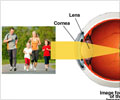Fusarium, the fungus implicated in recent eye infections among soft contact lens wearers, is associated with an increasing number of cases of keratitis (corneal swelling and inflammation)
CHICAGO - Fusarium, the fungus implicated in recent eye infections among soft contact lens wearers, is associated with an increasing number of cases of keratitis (corneal swelling and inflammation), according to a report published online today in Archives of Ophthalmology, one of the JAMA/Archives journals.
Infections caused by fungi can be devastating to both the structure of the eye and the patient's vision, according to background information in the article. Keratitis, or swelling and inflammation of the transparent membrane known as the cornea, has been associated with wearing soft contact lenses, but such infections usually have not been caused by fungi. At the authors' institution in south Florida, only three cases of fungal keratitis associated with contact lenses were seen between 1969 and 1977, two between 1977 and 1982 and five between 1982 and 1992.Eduardo C. Alfonso, M.D., and colleagues at the University of Miami, Miller School of Medicine, report 34 cases of fungal keratitis among soft contact lens wearers from January 2004 to April 2006. The researchers reviewed all 34 patients' medical records and report the clinical characteristics of the infections, the treatment prescribed and the microbiologic features.
All of the cases were associated with the fungus known as Fusarium. The average age of the patients was 34.9 years with a range of 13 to 92 years; 14 were male and 20 female. None had a history of disease that would predispose them to fungal eye infections. Among the 13 patients who could identify the type of contact lens solution they used, 12 reported that they had used some type of ReNu brand solution. This included two who reported that they had used ReNu MoistureLoc, the solution implicated in recent Fusarium outbreaks in the United States and Singapore, and nine who used ReNu brand without specifying a particular product.
Most patients were originally assumed to have a bacterial infection and were treated with antibiotics. The average time from the development of symptoms to accurate diagnosis was 9.1 days. After the diagnosis of fungal keratitis, patients were treated with topical (applied to the eye) or systemic (taken internally) antifungal medication for an average of 67.1 days. Two cases required surgery. The length of time between the first symptoms and the beginning of antifungal treatment appeared to be related to treatment outcomes; those patients for whom seven days or more passed between symptom onset and treatment had infections that took longer to cure. "Based on treatment experience in this series, it is our clinical impression that earlier correct diagnosis with institution of proper specific antifungal therapy resulted in a speedier resolution of the keratitis," the authors write.
The cause for the increased prevalence of Fusarium keratitis is not known, they continue; more research is needed. Until then, physicians should remain aware of the outbreak. "Ulcerative keratitis in a soft contact lens wearer should suggest possible Fusarium or other fungal species in addition to bacteria, parasites or viruses as causative organisms," the authors conclude. "Clinicians should conduct the necessary clinical and laboratory investigations to establish a specific diagnosis promptly to initiate the most specific, efficacious therapy."
In an additional report published online today in Archives of Ophthalmology, Maria D. Bernal, M.D., and colleagues at the University of California, San Francisco, report on four additional cases of Fusarium in soft contact lens wearers that occurred during five weeks in early 2006. "Our report strongly suggests that the current cluster represents an unusual spike over the background incidence of Fusarium keratitis seen during the prior 30 years at our institution," the authors report. "We, other laboratories, and the Centers for Disease Control and Prevention are currently investigating the fungicidal properties of the contact lens solutions used by these patients and the genotype characteristics of the Fusarium isolates in an effort to determine the underlying cause of the current apparent outbreak and whether the Fusarium species from these cases originate from a common strain."
Advertisement











